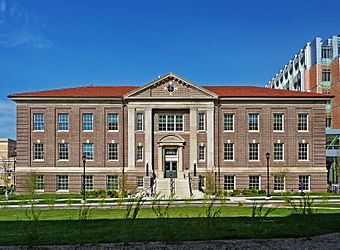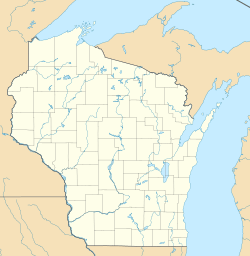DeLuca Biochemistry Building facts for kids
Quick facts for kids |
|
|
Agricultural Chemistry Building
|
|
 |
|
| Location | 420 Henry Mall, University of Wisconsin campus, Madison, Wisconsin |
|---|---|
| Built | 1912 |
| Architect | Warren Powers Laird & Paul Philippe Cret |
| Architectural style | Colonial Revival, Georgian Revival |
| NRHP reference No. | 85001356 |
| Added to NRHP | June 19, 1985 |
The Hector F. DeLuca Biochemistry Building is a very important place at the University of Wisconsin–Madison. It was first called the Agricultural Chemistry Building. This building is famous because scientists here discovered vitamins A and B. They also figured out how to process vitamin D.
Contents
A Place for Big Discoveries
This building became a center for amazing science thanks to a big project. In 1907, two scientists, Stephen Moulton Babcock and Elmer McCollum, started a special experiment. They wanted to find out what foods were most important for good health. This research helped create the field of agricultural chemistry at the university.
When the Agricultural Chemistry Building was finished in 1912, their important experiments moved inside. They kept working to find the key parts of healthy food.
Discovering Vitamins
In 1913, Elmer McCollum made a huge discovery. He found a special molecule in egg yolks that was vital for health. He called it vitamin A. This discovery fit with ideas about nutrition that another scientist, Frederick Gowland Hopkins, had shared a year earlier.
The research continued, and in 1915, McCollum found another important molecule. This time, it was in rice, and he named it vitamin B.
After McCollum left in 1917, Harry Steenbock took over. He kept studying these new molecules. In 1920, he successfully separated vitamin A and officially gave it that name.
Vitamin D and Bone Health
Harry Steenbock's research led to even more breakthroughs. He found that iron and copper could help treat anemia, a condition where your blood doesn't have enough healthy red cells.
His most famous discovery came in 1923. Steenbock found a link between vitamin D and ultraviolet light. He showed that shining ultraviolet light on certain foods could increase their vitamin D content. This was a big deal for bone health!
In 1928, he created the "Steenbock Process." This was a way to add lots of vitamin D to food by using light. This method was used widely through his Wisconsin Alumni Research Foundation.
More Important Discoveries
Other scientists in the building also made key discoveries:
- In 1937, Conrad Elvehjem found nicotinic acid (now called niacin). This discovery helped cure pellagra, a serious disease.
- In 1941, Karl Paul Link identified dicumarol. This substance helps stop blood from clotting too much.
The building was recognized for its importance on June 19, 1985. It was added to the National Register of Historic Places. In 2012, the building was updated and became part of the Biochemical Sciences Complex.
In 2013, the building was named after Hector F. DeLuca. He did all his research at UW-Madison. His work helped identify the active forms of vitamin D, leading to many new medicines.
The building is part of the Henry Mall Historic District, a special area on campus.
Building Style
The Hector F. DeLuca Biochemistry Building has a classic look. It is built in the Georgian Revival style. You can see this in its triangular roof part (pediment), corner decorations (quoins), and decorative railing (balustrade).
The building was designed by Warren Powers Laird and Paul Philippe Cret. They also designed several other buildings on the campus, including the Stock Pavilion and Sterling Hall.



